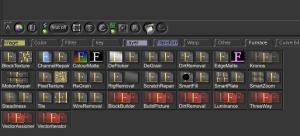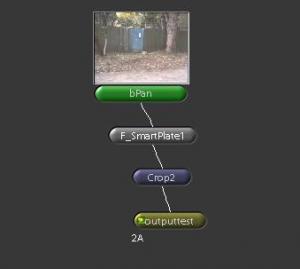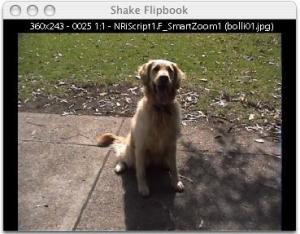The Foundry has been a long time plug-in favorite, and recently broke with other vendors and started offering free burn support (see fxguide story here). With the release of Furnace 2.0 they are offering new tools that offer that “sizzle” we all seek to solve creative problems and make our clients take notice. Mike Seymour has a review posted from IBC.
“The world just doesn’t need another lens flare”, declares founder Simon Robinson in summing up the Foundry’s move into new image processing technology sparks. With Furnace 1.0 and now with the release of Furnace 2.0, the UK’s Foundry has aimed to “fill in more of the gaps” in the post production toolset. Furnace 2.0 concentrates on image preparation tools and includes automated dust busting and scratch removal, automatic matte generation, based their motion estimation technology. These new nine plug-ins are in addition to the original ten sparks release two years ago. Fxguide tested the new Furnace plugins on Shake under OSX. The software was only beta, but with a little work, the results were outstanding.

Where the Furnace plugins have proved strongest is in providing new and innovative image processing tools to broader products such as Shake and Flame. Both Apple and Discreet have provided strong compositing tools, but not really provided innovative “Siggraph-level” image processing bells and whistles in recent years. So if you have found your tools set lacking any client stopping features, – Furnace 2 is pure sex.
The first set of new sparks in the Furnace 2.0 product are aimed at reducing time consuming roto. They consist of two matte generation tools aimed to providing matte by colour or edges. Roto tools have improved over time, but any way one can find to avoid it all together is to be applauded. The new plug-ins is this group are: ColourMatte, EdgeMatte, and Motion Matte.
The next set of sparks aims to build on the rig removal tools of Furnace 1.0. They include the new sparks ScratchRemoval, DirtRemoval and SmartFill, which uses pixels from the surrounding region of the image to produce a realistic repair. Dust busting is a painful job, and using spacial repair with motion compensation allows these sparks to quickly and easily remove most problems.
The new ChannelRepair tool is useful for removing damage in one of the color channels, such as might happen with chemical damage. Information from the other two color layers is used to recreate the information needed for the damaged channel. Motion repair is used to generate a single in-between frame from two images….useful to repair damage on a single frame.
 But it is SmartPlate, SmartLooper, and SmartZoom that really move Furnace 2 into the client ‘wow’ factor. We could not test drive SmartLooper as it will not be shipping on the Shake platform (only on discreet systems), since ” there is no way we can find to make this practical in Shake (both from a coding point of view and from a usability point of view).” explained Victoria Hamilton Sales & Marketing Manager for the Foundry. The missing Smartlooper is based in part on the same theory that was explored in a series of recent Siggraph papers. The spark will find or create loop cycles from material such as someone on an exercise bike. The loops allow you to create infinite video textures or motion cycles – without either spacial or temporial popping. Not only does the movements of the action match but subtle lighting changes are all dovetailed into each other – making the edit points on the test material we examined, almost impossible to find.
But it is SmartPlate, SmartLooper, and SmartZoom that really move Furnace 2 into the client ‘wow’ factor. We could not test drive SmartLooper as it will not be shipping on the Shake platform (only on discreet systems), since ” there is no way we can find to make this practical in Shake (both from a coding point of view and from a usability point of view).” explained Victoria Hamilton Sales & Marketing Manager for the Foundry. The missing Smartlooper is based in part on the same theory that was explored in a series of recent Siggraph papers. The spark will find or create loop cycles from material such as someone on an exercise bike. The loops allow you to create infinite video textures or motion cycles – without either spacial or temporial popping. Not only does the movements of the action match but subtle lighting changes are all dovetailed into each other – making the edit points on the test material we examined, almost impossible to find.
SmartPlate uses the Foundry’s advanced motion estimation to take a clip – such as a panning or tracking shot and generate one huge continuous single seamless image. We tested in a park, shooting children (who are never still) handheld on mini-dv, – far from safest approach. In Shake, a SmartPlate node is attached to the source clip and then a crop node below that defines how big your final output file will be. For our tests we started with 768 x 576 PAL mini-dv clip and produced a 2060 x 576 still panorama. The image is seamless – but the process is not without its tricks. If you pan the original camera too quickly the source frames will be blurred resulting in a blurred image. Blurring can also result from the overlaying of too many images. The default settings did not work well in our testing but the “limit blend” option – which ensures later frames do not overwrite earlier ones worked extremely well. In speaking with the developers at IBC, they are also planning on adding the ability to put the camera move back into the shot. While we obviously couldn’t view this in action, this could be useful if you want to fix something in a scene or add something to a scene. You would generate a single large image, fix the image, and then apply the camera move back to the shot.
Compare the default full-blend results (Ieft) with the more intelligent limit blend option (right) below


The process is not fast. To ensure the source frames were not motion blurred our test example was built from a slow pan of over 300 frames, which of course did not help with processing time. While it is possible in Shake to render every second, third or nth frame of an output node, this will not work with SmartPlate, but you can change the frame sampling on the FileIn node in order to sample fewer input frames. With a little bit of experimentation, you can find the ideal ratio of frames that you need.
 The final spark in this pack is called SmartZoom. It is designed to build a series of almost identical frames into a higher resolution still image. Shot an almost locked off sequence at say NTSC resoulution and the output can be an HD resolution frame is the theory. Actually, the output can be any integer multiple of the original and then resized like normal to the size of your choice. The spark works by constantly building a resampled master still, not unlike the way a Compound function works on a Flame, cleaning up and removing film grain, by effectively combining multiple frames. But a Compound function on Flame returns only the same resolution output as the source. Also unlike the Compound function which works best on completely locked off material, Smart Zoom requires different ‘views’ of the original to resample and resample to a higher resolution image. At present the spark can result in a slight ringing on high contrast edges, not dissimilar to a Sharpen filter, but The Foundry assured us that this would be fixed by release.
The final spark in this pack is called SmartZoom. It is designed to build a series of almost identical frames into a higher resolution still image. Shot an almost locked off sequence at say NTSC resoulution and the output can be an HD resolution frame is the theory. Actually, the output can be any integer multiple of the original and then resized like normal to the size of your choice. The spark works by constantly building a resampled master still, not unlike the way a Compound function works on a Flame, cleaning up and removing film grain, by effectively combining multiple frames. But a Compound function on Flame returns only the same resolution output as the source. Also unlike the Compound function which works best on completely locked off material, Smart Zoom requires different ‘views’ of the original to resample and resample to a higher resolution image. At present the spark can result in a slight ringing on high contrast edges, not dissimilar to a Sharpen filter, but The Foundry assured us that this would be fixed by release.
The Foundry is to be commended for pushing forward with new image processing technologies and avoiding the gimmicky posterize sparks that while novel – are rarely used and almost always impossible to control and extend. Furnace 2 runs under IRIX, Linux, OSX and Windows.
